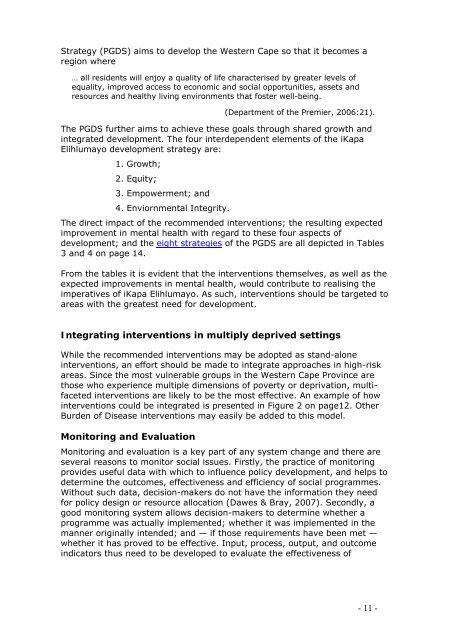(Volume 4) - Mental Health Disorders - Vula - University of Cape Town
(Volume 4) - Mental Health Disorders - Vula - University of Cape Town
(Volume 4) - Mental Health Disorders - Vula - University of Cape Town
You also want an ePaper? Increase the reach of your titles
YUMPU automatically turns print PDFs into web optimized ePapers that Google loves.
Strategy (PGDS) aims to develop the Western <strong>Cape</strong> so that it becomes aregion where… all residents will enjoy a quality <strong>of</strong> life characterised by greater levels <strong>of</strong>equality, improved access to economic and social opportunities, assets andresources and healthy living environments that foster well-being.(Department <strong>of</strong> the Premier, 2006:21).The PGDS further aims to achieve these goals through shared growth andintegrated development. The four interdependent elements <strong>of</strong> the iKapaElihlumayo development strategy are:1. Growth;2. Equity;3. Empowerment; and4. Enviornmental Integrity.The direct impact <strong>of</strong> the recommended interventions; the resulting expectedimprovement in mental health with regard to these four aspects <strong>of</strong>development; and the eight strategies <strong>of</strong> the PGDS are all depicted in Tables3 and 4 on page 14.From the tables it is evident that the interventions themselves, as well as theexpected improvements in mental health, would contribute to realising theimperatives <strong>of</strong> iKapa Elihlumayo. As such, interventions should be targeted toareas with the greatest need for development.Integrating interventions in multiply deprived settingsWhile the recommended interventions may be adopted as stand-aloneinterventions, an effort should be made to integrate approaches in high-riskareas. Since the most vulnerable groups in the Western <strong>Cape</strong> Province arethose who experience multiple dimensions <strong>of</strong> poverty or deprivation, multifacetedinterventions are likely to be the most effective. An example <strong>of</strong> howinterventions could be integrated is presented in Figure 2 on page12. OtherBurden <strong>of</strong> Disease interventions may easily be added to this model.Monitoring and EvaluationMonitoring and evaluation is a key part <strong>of</strong> any system change and there areseveral reasons to monitor social issues. Firstly, the practice <strong>of</strong> monitoringprovides useful data with which to influence policy development, and helps todetermine the outcomes, effectiveness and efficiency <strong>of</strong> social programmes.Without such data, decision-makers do not have the information they needfor policy design or resource allocation (Dawes & Bray, 2007). Secondly, agood monitoring system allows decision-makers to determine whether aprogramme was actually implemented; whether it was implemented in themanner originally intended; and — if those requirements have been met —whether it has proved to be effective. Input, process, output, and outcomeindicators thus need to be developed to evaluate the effectiveness <strong>of</strong>- 11 -

















